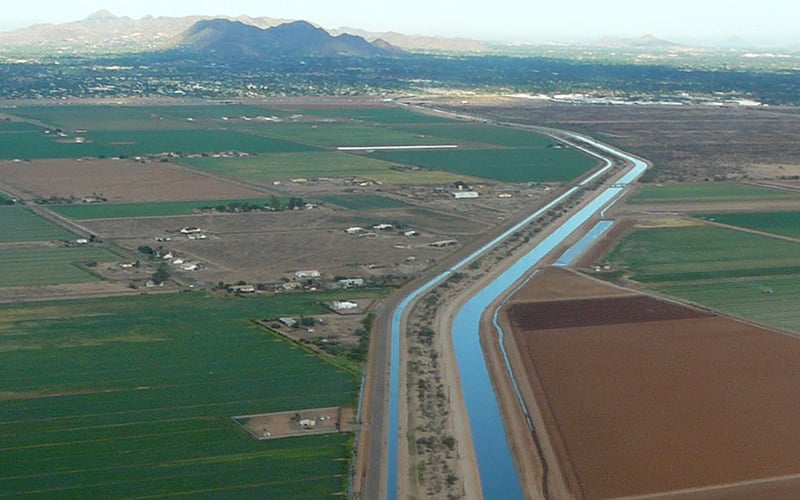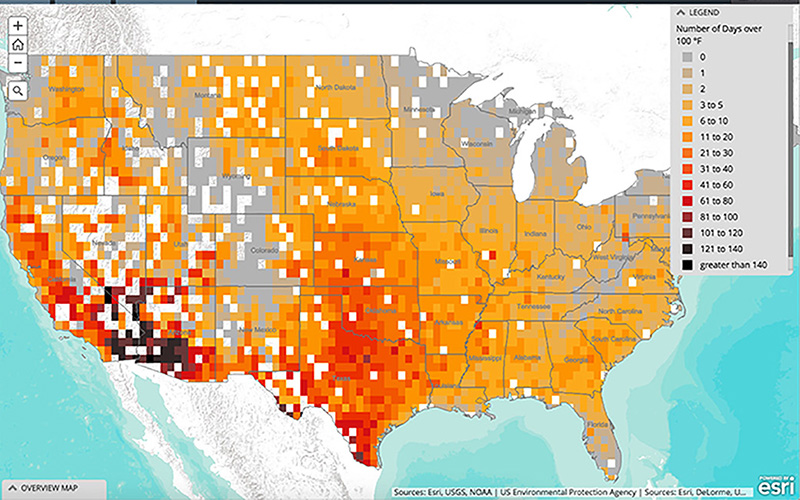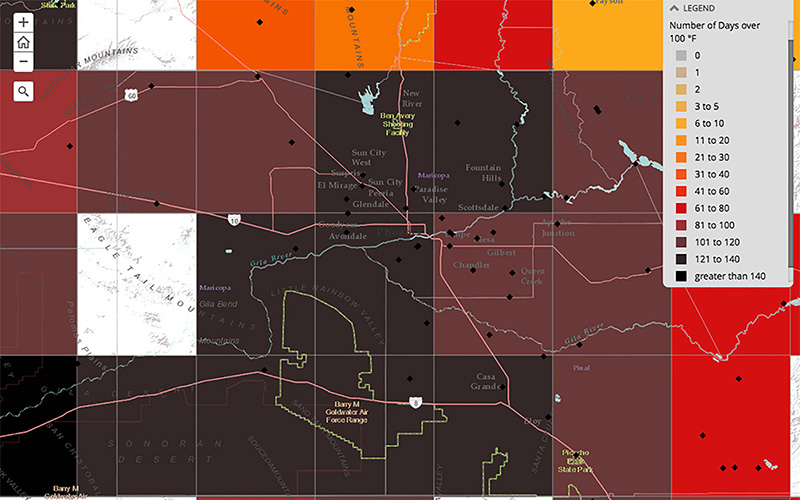
The Arizona Canal cuts through the Salt River-Pima Indian Community east of Scottsdale. Despite predictions of steadily rising temperatures, state officials are confident Arizona’s water resources are prepared. (Photo Courtesy of the Arizona Department of Water Resources)

The EPA created a new tool aimed at helping water utilities across the country understand, and prepare for, the impact of climate change. The tool presents a variety of scenarios, including heat, precipitation and storms. (Map courtesy the Environmental Protection Agency)

Some areas of the Valley could see 100 to 140 days of extreme heat within 20 years, according to predictions from the EPA’s climate mapping tool. The darkest areas on the map could see triple-digit heat for up to 140 days a year. (Map courtesy Environmental Protection Agency)
WASHINGTON – Some parts of southwest Arizona could experience more than 140 days of temperatures above 100 degrees within 20 years, according to a climate change model from the Environmental Protection Agency.
The impact of rising temperatures would be most dramatic between Phoenix and Yuma, but areas all across Arizona could see greater vulnerability to drought, with extreme heat straining water resources. But water utilities and state agencies say they are confident that the state has been careful in its water use, and communities and water utilities have developed responses to changing climates for years.
“Here in Arizona, we manage water very differently than other states,” said Michelle Moreno, spokeswoman at the Arizona Department of Water Resources. “There are mandatory conservation requirements for different types of users.”
The EPA released the models as a tool that includes predictions, case studies and best practices to help local utilities plan for the effects of a changing climate. It plans to release additional case studies later this year that are specific to the Southwest.
Editor’s note:
A previous version of this story may have left an incorrect impression about the impact of projected climate changes in the state. While some parts of Arizona could see 100 days above 100 degrees in 20 years, southwestern parts of the state could have more than 140 such days. The story here has been revised to clarify, but clients who used previous versions of this story are asked to run the clarification that can be found here.
But the EPA noted that any plans should be developed using local knowledge on how climate conditions could affect water supply and demand – something Arizona officials who deal with water say they have a handle on.
“When these reports or tools come out, it gives the impression that we have a lot of issues,” Moreno said. “We may have a lot of dry days here in Arizona, but that doesn’t mean that we’re impacted the same way (as other parts of the country).”
The Department of Water Resources manages long-term water supplies in the state, and enforces regulations in what are known as “active management areas.” Eighty percent of Arizona residents live within an active management area, with water systems that draw from a number of different sources: surface water, groundwater, reclaimed wastewater.
These systems are all required to develop plans to deal with drought or system failures. Additionally, any new water utility must demonstrate to the department that there’s adequate water supply before the utility will be approved by the Arizona Corporation Commission. The commission does not have a formal drought resiliency requirement, however, commission spokeswoman Angie Holdsworth said.
Water demand fluctuates throughout the year, and more extreme heat days may lead to more demand across the state, said Jake Lenderking, water resources manager at EPCOR Utilities, Arizona’s largest regulated water utility.
“Simply, our water demand throughout the year follows the weather,” he said. “In the winter, people use less water. In the summer, there are more daylight hours, and there is more heat. A lot more heat would drive water use up.”
Besides increasing demand, the EPA says rising temperatures could alter surface water quality, presenting new challenges to make sure the water is safe to use.
Overall water use is down across the U.S. as cities, farmers and consumers turn to technologies that make consumption more efficient, and consumers have become more mindful of water use.
“We’ve seen water demand, in general, go down,” Lenderking said. “There’s this big overlying trend, in the Southwest we see it going down a lot faster.
“One of the things that we don’t know today is: Do we still see this general trend as it gets hotter and hotter? We may see demand increase, or it may decrease even more,” he said. “That’s something we’re trying to study.”
EPCOR partnered with other utilities and the Bureau of Reclamation to study water demand of the Salt River basin, making sure there is enough future supply for the predicted demand in the basin.
Outside the Valley, Moreno said, rural areas may be more vulnerable to rising temperatures, and extreme heat may lead to additional restrictions on residents or local businesses.
“There are some rural areas in the state that rely exclusively on groundwater,” she said. “If we’re not getting any rain, those water systems have that drought plan. If our wells aren’t able to produce enough water, we’re going to tap into another system.”
The state has issued a drought emergency declaration every year since 1999, allowing rural and ranching communities to apply for federal assistance and allow the state to step in if needed.